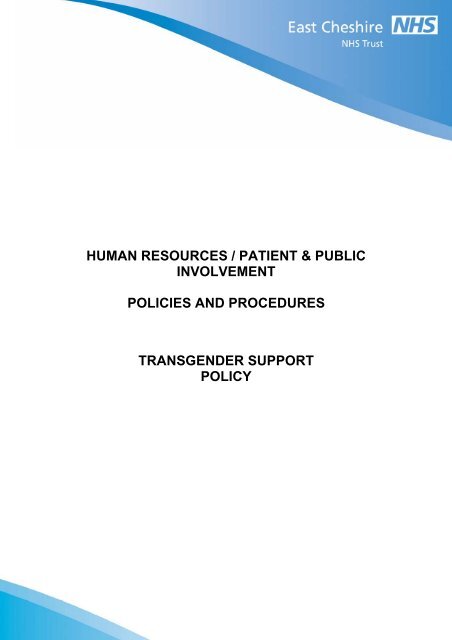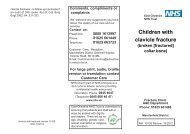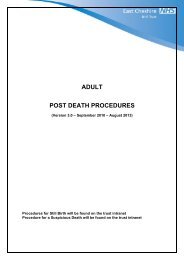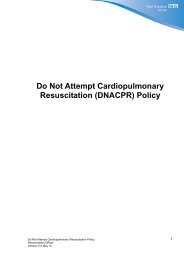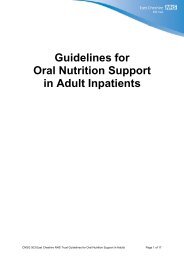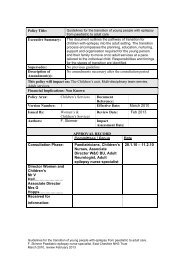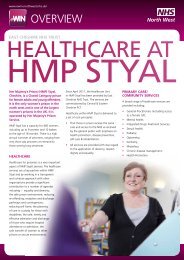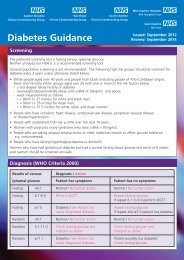Transgender Support 1798.pdf - East Cheshire NHS Trust
Transgender Support 1798.pdf - East Cheshire NHS Trust
Transgender Support 1798.pdf - East Cheshire NHS Trust
You also want an ePaper? Increase the reach of your titles
YUMPU automatically turns print PDFs into web optimized ePapers that Google loves.
HUMAN RESOURCES / PATIENT & PUBLIC<br />
INVOLVEMENT<br />
POLICIES AND PROCEDURES<br />
TRANSGENDER SUPPORT<br />
POLICY
Policy Title<br />
Executive Summary:<br />
<strong>Transgender</strong> <strong>Support</strong> Policy<br />
The aim of this policy is to communicate <strong>East</strong> <strong>Cheshire</strong> <strong>NHS</strong> <strong>Trust</strong>’s<br />
commitment to the promotion of equality.<br />
The policy seeks to ensure that the provision for <strong>Transgender</strong> people is<br />
responsive to individual need; is prejudice free and challenges the<br />
discrimination individuals may experience. The policy will provide a<br />
framework for managers and clinical staff to support staff and service<br />
users who identify with a gender other than that assigned at birth<br />
Supersedes:<br />
Not Applicable<br />
Description of Not Applicable<br />
Amendment(s):<br />
This policy will impact on:<br />
Patients, employees, applicants, contractors, volunteers, agency staff and visitors to the <strong>Trust</strong><br />
Financial Implications:<br />
Limited financial impact.<br />
Policy Area: HR Document Reference:<br />
Version Number: 1.0 Effective Date: 26.1.2011<br />
Issued By:<br />
Chief Operating Officer andReview Date: 31.12.2013<br />
Director of HR & Workforce<br />
Author: Ruth Knighton, HRBP Impact Assessment<br />
Date:<br />
January 2011<br />
APPROVAL RECORD<br />
Committees / Group<br />
Date<br />
Consultation: Management & HR Team 20.12.2010<br />
The Gender <strong>Trust</strong> 29.12.2010<br />
Formal JCNC 26.1.2011<br />
Approved by Director: January 2011<br />
Received for information: Operational Communication Forum<br />
Associate Director’s Group<br />
2<br />
Author: HR Business Partner<br />
Version: 1.0<br />
January 2011
CONTENTS PAGE<br />
Page<br />
1. Policy Statement 4<br />
2. Organisational Responsibilities 4<br />
3. Statement of Intent / Scope 4<br />
4. Definitions 5<br />
5. Legislation 6<br />
6. The Policy - Employment 8<br />
7. The Policy – Service Provision 11<br />
8. Planning & Implementation 13<br />
9. Measuring Performance 13<br />
10. Audit 14<br />
11. Review 14<br />
12. Further Reading 14<br />
13. Impact Assessment 15<br />
3<br />
Author: HR Business Partner<br />
Version: 1.0<br />
January 2011
1. POLICY STATEMENT<br />
<strong>East</strong> <strong>Cheshire</strong> <strong>NHS</strong> <strong>Trust</strong> is committed to equality for all communities and to providing services<br />
which are accessible, appropriate and which recognize the diversity of people, their needs and<br />
choices.<br />
To deliver a patient led service the <strong>Trust</strong> must ensure that services and care delivery recognise the<br />
needs of each individual service user. The <strong>Trust</strong> recognises that <strong>Transgender</strong> (Trans) service<br />
users and staff may experience discrimination. <strong>East</strong> <strong>Cheshire</strong> <strong>NHS</strong> <strong>Trust</strong> is clear that it does not<br />
tolerate discrimination directly or indirectly against any person including Trans people.<br />
2. ORGANISATIONAL RESPONSIBILITIES<br />
2.1 The role of the <strong>Trust</strong> Board<br />
The Board and the <strong>Trust</strong> Management Team have a responsibility to develop a culture and<br />
climate in which employees can excel at work and maximise their potential regardless of<br />
their transgender status and be free from any form of bullying and harassment behaviour.<br />
2.2 The role of the Chief Operating Officer and Director of HR & Workforce<br />
To oversee the introduction, operation and monitoring of the policy.<br />
2.3 The role of Equality and Diversity Leads<br />
The E&D Leads are responsible for providing appropriate advice and guidance to all staff<br />
on the use of the policy and its application generally and specifically (i.e. individual cases).<br />
HR will provide an advisory role to managers and staff in respect of the procedure and<br />
appropriate solutions. The Patient and Public Involvement Manager will provide advice to<br />
service providers and service users in the implementation of this Policy.<br />
2.4 The Role of Individual Staff<br />
Every employee has a personal responsibility for their own behaviour and must treat their<br />
colleagues, patients and visitors with respect and fairness regardless of their gender, sex,<br />
race, nationality, age, disability, religion or beliefs.<br />
3. STATEMENT OF INTENT / SCOPE<br />
3.1 This policy applies to all those working in the <strong>Trust</strong>, in whatever capacity. A failure to follow<br />
the requirements of the policy may result in investigation and management action being<br />
taken as considered appropriate.<br />
3.2 This may include formal action in line with the <strong>Trust</strong>'s disciplinary or capability procedures<br />
for <strong>Trust</strong> employees; and other action in relation to other workers, which may result in the<br />
termination of an assignment, placement, secondment or honorary arrangement.<br />
3.3 If it is alleged that a service user is subject to discrimination this should be reported to the<br />
person in charge of the service area and an incident report completed and sent to the Risk<br />
Management Department for investigation and reporting. This will automatically be copied<br />
to the service lead for Equality & Human Rights. Should the subject of the allegation be the<br />
person in charge of the service area, the issue should be escalated to their line manager.<br />
4<br />
Author: HR Business Partner<br />
Version: 1.0<br />
January 2011
4. DEFINITIONS<br />
4.1 <strong>Transgender</strong> Person<br />
This is a person whose own identity does not confirm to the sex they were assigned at<br />
birth.<br />
4.2 Transsexual Person<br />
A person who lives (or wishes to live) permanently in their ‘new’ gender. In the United<br />
Kingdom, those who are intending to undergo, undergoing or having undergone gender<br />
reassignment, under medical care are protected in law. Those who have changed their role<br />
permanently may obtain legal recognition of their new gender status in accordance with the<br />
Gender Recognition Act.<br />
4.3 Trans<br />
The expression Trans is an inclusive term for all people who cross gender boundaries<br />
permanently or temporarily. This would include people who identify as transexual,<br />
transgender, transvestite or simply trans. Sometimes its use is specific; for instance, those<br />
born as female but identifying as men may be referred to as Trans men; and those born as<br />
male but identifying as women may be referred to as Trans women. Where Trans people<br />
have transitioned permanently, many prefer to be regarded as ordinary men and women.<br />
For the purpose of this document the term Trans and Trans people will be used as it is a<br />
more encompassing term and generally accepted by the Trans community.<br />
4.4 Gender Identity<br />
Gender Identity describes the gender a person identifies with. This is not necessarily the<br />
same as the sex they were assigned at birth. It is not necessarily based on biological fact,<br />
either real or perceived, nor is it always based on sexual orientation.<br />
4.5 Gender Dysphoria<br />
A medical diagnosis of a consistent and overwhelming desire to live in the opposite gender<br />
to that assigned at birth,<br />
4.6 Sex Reassignment Therapy (or Gender Reassignment)<br />
The process of transitioning from the gender assigned at birth to the gender the person<br />
identifies with. This may involve medical and surgical procedures. Many people simply call<br />
this process transition.<br />
In addition to undergoing medical procedures, transsexual people who go through sex<br />
reassignment therapy usually change their social gender roles, legal names and legal sex<br />
designation. Transition describes the point at which a permanent change of gender role is<br />
undertaken, in all spheres of life - in the family, at work, in leisure pursuits and in society<br />
generally. Some people make this change gradually, however, others emerge overnight.<br />
4.7 Legal Sex<br />
In the past in the UK, the legal sex of someone was defined by their birth certificate and<br />
could not be changed. The Gender Recognition Act 2004 means people can now apply to<br />
gain recognition of their change of gender for all legal purposes.<br />
4.8 Transphobia<br />
A fear and dislike of <strong>Transgender</strong> people, which can lead to hatred resulting in verbal or<br />
physical attacks and abuse.<br />
5<br />
Author: HR Business Partner<br />
Version: 1.0<br />
January 2011
4.9 Sexual Orientation<br />
Sexual orientation is a separate issue from gender identity. Trans people may be gay,<br />
lesbian, bisexual, heterosexual or, occasionally, asexual. Their sexual relationships may<br />
remain the same through the transition process, or they may change.<br />
5. LEGISLATION<br />
5.1 Sex Discrimination Act 1975 – Under this act it is unlawful for employers to discriminate<br />
on grounds of sex, marriage, pregnancy and maternity leave or because someone intends<br />
to undergo, is undergoing or has undergone, gender reassignment.<br />
5.2 The Sex Discrimination (Gender Reassignment) Regulations 1999 amended the Sex<br />
Discrimination Act 1975 and was extended to prohibit discrimination on the grounds of<br />
gender reassignment in both employment and vocational training.<br />
In employment and vocational training, the Sex Discrimination Act protects individuals who<br />
are discriminated against because they:<br />
<br />
<br />
<br />
Intend to undergo gender reassignment<br />
Are currently undergoing gender reassignment<br />
Have already undergone gender reassignment<br />
5.3 The Gender Recognition Act 2004<br />
The Act gives transgender people legal recognition as members of the sex appropriate to<br />
their gender (male or female) allowing them to acquire a new birth certificate, affording<br />
them full recognition of their acquired sex in law for all purposes, including marriage.<br />
People present evidence to a Gender Recognition Panel, which considers their case and<br />
issues a Gender Recognition Certificate (GRC). If the person involved is in a legally<br />
recognised marriage they will be issued an “Interim Gender Recognition Certificate”, which<br />
can then be used as grounds for annulment of the marriage, but otherwise has no status.<br />
After annulment, a full Certificate will be issued.<br />
The Act requires applicants to have transitioned two years before a certificate is issued. It<br />
makes no requirement for sex reassignment surgery to have taken place, although such<br />
surgery will be accepted as part of the supporting evidence for a case where it has taken<br />
place. A birth certificate drawn from the Gender Recognition register is indistinguishable<br />
from any other birth certificate, and will indicate the new legal sex and name.<br />
The Gender Recognition Act safeguards the privacy of transsexuals by prohibiting the<br />
disclosure of information acquired in an official capacity relating to a gender recognition<br />
certificate or about the gender history of a successful applicant. It is a criminal offence to<br />
disclose such information and subject to a maximum £5000 fine. It is not, however, an<br />
offence to disclose ‘protected information’ if the person cannot be identified or if the<br />
individual gives their consent. However, it should be recognised that to even publicly<br />
acknowledge that there is a transsexual employee could result in ‘outing’ them.<br />
A <strong>Transgender</strong>ed person should not be treated less favourably because they do not<br />
possess a Gender Recognition Certificate. Providing a person is living fully in an acquired<br />
gender role, they should be treated equally to a person who is in possession of a Gender<br />
Recognition Certificate.<br />
6<br />
Author: HR Business Partner<br />
Version: 1.0<br />
January 2011
5.4 Human Rights Act 1998<br />
The Human Rights Act 1998 gives further legal effect in the UK to the fundamental rights<br />
and freedoms contained in the European Convention on Human Rights. These rights not<br />
only impact matters of life and death, they also affect the rights you have in your everyday<br />
life: what you can say and do, your beliefs, your right to a fair trial and other similar basic<br />
entitlements.<br />
Most rights have limits to ensure that they do not unfairly damage other people's<br />
rights. However, certain rights – such as the right not to be tortured – can never be limited<br />
by a court or anybody else.<br />
5.5 Genuine Occupational Requirement (GOR) – Following legal recognition of an individual,<br />
the entire body of employment law must be interpreted on the basis that Trans people are<br />
regarded for all purposes as a member of the acquired gender.<br />
If the single sex GOR applies to a post and the job holder changes gender then it is<br />
reasonable for the <strong>Trust</strong> to reconsider the continuation of the job holder within the post.<br />
The <strong>Trust</strong> must treat the individual reasonably in all circumstances.<br />
5.6 Equality Act 2010<br />
The Equality Act came into force on 1 st October 2010 and defines gender reassignment as<br />
a protected characteristic.<br />
People who are proposing to undergo, are undergoing or have undergone a process (or<br />
part of a process) to change their gender by changing physiological or other attributes of<br />
gender have the protected characteristic of gender reassignment.<br />
7<br />
Author: HR Business Partner<br />
Version: 1.0<br />
January 2011
6. THE POLICY - EMPLOYMENT<br />
6.1 Employment<br />
Staff will be treated in their acquired gender for all purposes of daily living from the point<br />
they commence a real life test to live and work in their new gender role.<br />
All employees must observe the privacy of transsexuals afforded by the Gender<br />
Recognition Act. Breaches of confidentiality will be treated in accordance with the <strong>Trust</strong>’s<br />
Disciplinary Procedure.<br />
6.2 Recruitment and Selection<br />
There is no barrier to a person who identifies as Trans from applying for employment within<br />
<strong>East</strong> <strong>Cheshire</strong> <strong>NHS</strong> <strong>Trust</strong>. All those involved in the recruitment and selection process<br />
should be made aware of their responsibilities to select fairly and without prejudice.<br />
6.3 Confidentiality within the recruitment and selection process<br />
Applicants do not have to disclose their transgender status during the recruitment and<br />
selection process including at interview, or as any condition of employment.<br />
If applicants choose to disclose their status this must not be used as a reason for not<br />
offering the person employment with the <strong>Trust</strong> and also non-disclosure or subsequent<br />
disclosure are not grounds for dismissal.<br />
6.4 Records and Information Sharing<br />
All personnel records must be updated at the start of the transition process. At this point,<br />
the member of staff will be able to apply for a driving license and passport in their new<br />
acquired gender.<br />
A new personnel file will be created to ensure confidentiality. It will be necessary to retain<br />
records relating to a member of staff’s identity at birth prior to obtaining a full GRC,<br />
however, once the member of staff has obtained this, such records must be replaced with<br />
the new details. The old personnel file will not be destroyed but access to this will be<br />
restricted to the Head of Human Resources and appropriate Head of Service.<br />
The line manager should also ensure that all information held in telephone directories,<br />
email address and employment details reflect the acquired gender of the person.<br />
If giving a reference, the reference should be in the name which will be used in the new job<br />
and must not disclose a former name. It may sometimes be necessary for a transsexual<br />
person to disclose a previous identity in order for references from past employers to be<br />
obtained. In these cases, strict confidentiality and respect for dignity should be applied.<br />
Those staff who are professionally registered are advised to contact their professional<br />
bodies to find out whether there are any specific requirements in terms of name changes<br />
etc. Where the <strong>Trust</strong> has to keep evidence of professional status or qualifications, it should<br />
be discussed with the member of staff how this information will be retained so as not to<br />
compromise or breach disclosure of protected information.<br />
A person who as changed their gender role and living in their acquired gender role does<br />
not have to be in possession of a GRC to be afforded equal treatment to a person who is in<br />
possession of a GRC.<br />
8<br />
Author: HR Business Partner<br />
Version: 1.0<br />
January 2011
6.5 Criminal Records Bureau Checks (CRB)<br />
Staff who work in the <strong>NHS</strong> are required to have a CRB check. Part of this process involves<br />
a strict requirement for applicants to state all previous names and aliases. CRB checks<br />
however should not be a problem for Trans people. The CRB has a confidential checking<br />
process for <strong>Transgender</strong> people applications who do not wish to reveal details of their<br />
previous identity to the person who asked them to complete an application form for a CRB<br />
disclosure. The applicant may wish to contact CRB customer services 0151 676 1452 to<br />
discuss this matter in confidence.<br />
Trans applicants for a CRB disclosure should contact CRB on the above number to<br />
clarify anything they are not sure about and ensure that the CRB know they will be<br />
using the confidential checking process.<br />
The Trans applicant should complete the form presented by their employer in the<br />
normal way, except that they need not complete details (or supply forms of evidence)<br />
that would expose their gender history to their employer.<br />
If they wish to leave out details that could “out” them then they should photocopy the<br />
form, ensuring they have a clear record of the application serial number.<br />
The applicant should then immediately contact the CRB in Liverpool on the number<br />
above and notify them of the application number.<br />
The special security section of the CRB in Liverpool then have the means to intercept<br />
the application that was forwarded by the employer. They will ask the applicant to<br />
supply the information needed to replace that which was omitted.<br />
This is then married up so that a rigorous criminal records check can be carried out in<br />
the same way as for any other applicant.<br />
Disclosures sent to the employee and their employer will not reveal the applicants<br />
former identity unless they have an offence or caution that has been recorded in that<br />
name in Police records. In this case there is no way of avoiding the disclosure of that<br />
former identity to the employer.<br />
If the offence itself is not serious enough to preclude employment, reassurances should<br />
be given to the applicant /member of staff in this event.<br />
6.6 Accommodating Gender Transition in the Workplace<br />
<strong>East</strong> <strong>Cheshire</strong> <strong>NHS</strong> <strong>Trust</strong> is committed to supporting all its employees with regard to<br />
personal circumstances that may impact on work.<br />
6.6.1 Procedure<br />
Once an employee has decided they wish to undergo gender reassignment it is essential<br />
that a support network is set up as soon as possible to accommodate this. It is for the<br />
individual to decide whom to approach for advice and support, be it their line manager,<br />
Human Resources or trade union representative. Once this is agreed a member of Human<br />
Resources staff should be assigned to act as a contact for the individual concerned to<br />
answer any queries or action any requirements and act as an advisor. The appointed<br />
advisor will need to discuss with the individual how they wish to handle the transition. The<br />
following issues should be considered and agreed by both parties:<br />
a) The practicalities of remaining in their current post. (If the employee also has a<br />
disability then ‘reasonable adjustments’ would need to taken into account or existing<br />
arrangements would need to be transferred to a new post in line with the Disability<br />
Discrimination Act).<br />
b) The expected timescale for medical procedures (if to be undertaken) and any time<br />
off required for treatment.<br />
c) The expected point at which the change of name and personal details should occur.<br />
9<br />
Author: HR Business Partner<br />
Version: 1.0<br />
January 2011
d) Whether the employee wishes to inform the line manager, colleagues and other staff<br />
and clients, or would prefer the appointed advisor / a third party to inform them<br />
instead.<br />
e) Agreeing a point at which their individual gender specific dress will change.<br />
f) Agreeing a point at which the individual will change use of single sex toilets /<br />
changing facilities in their new gender. This could be from the first day of<br />
transitioning.<br />
g) Whether new arrangements will need to be made for any accommodation used for<br />
work purposes.<br />
6.6.2 Time off work<br />
In line with the <strong>Trust</strong>’s Absence Policy, any absence from work for medical requirements<br />
would need to be covered by a medical certificate. Any additional leave for specialist<br />
appointments would be classed the same as other hospital / GP appointments and in<br />
accordance with <strong>Trust</strong> Policy.<br />
6.6.3 <strong>Support</strong> Mechanisms<br />
The list below shows just some of the options available to individuals who wish to seek<br />
support within the organisation during a gender transition period. <strong>Support</strong> encompass<br />
identifying individual support needs; including additional diversity issues such as age,<br />
culture, disability, ethnicity, religion or sexual orientation.<br />
<br />
<br />
<br />
Human Resources. An appointed advisor from within the Human Resources<br />
department identified at an early stage to offer support; put in place practical changes<br />
that need to be made to an individual’s post or personal records; to support positive<br />
working relationships between the individual and wider team members if relevant. Any<br />
qualified Human Resources professional should have the necessary knowledge and<br />
awareness required to deal with such personal and sensitive issues.<br />
Occupational Health. A referral to occupational health may be considered by the<br />
individual, their manager or the human resources representative for additional support<br />
and advice concerning any counselling needs or advice regarding the medical process<br />
of the transition. Managers may also need advice regarding the needs of the individual<br />
and on how to support changes that may need to be made within the team or work<br />
environment.<br />
Equality and Diversity Lead. Someone who has specialist knowledge of issues in<br />
relation to Equality and Human Rights that can be used as a resource.<br />
6.7 Sharing Personal Information<br />
Under Section 22 of the Gender Recognition Act 2004 it is illegal for staff to share<br />
information regarding someone’s Trans status. The Gender Recognition Act states that:” It<br />
is an offence for a person who has acquired protected information in an official capacity to<br />
disclose the information to any other person” unless<br />
‣ There is specific agreement to do so by the Trans person.<br />
‣ If it is necessary for professionals to know someone’s Trans status then it is<br />
recommended that the Trans person is asked to provide permission in writing.<br />
10<br />
Author: HR Business Partner<br />
Version: 1.0<br />
January 2011
‣ The Secretary of State may by order make provision prescribing circumstances in<br />
which the disclosure of protected information is not to constitute an offence under<br />
this section.<br />
(For clarity on this issue see www.opsi.gov.uk Section 22 of the Gender Recognition Act<br />
2004)<br />
6.8 Single Sex Facilities<br />
Part of the process of gender reassignment involves a Trans person living as their acquired<br />
gender before undergoing surgery, if surgery is the desired outcome. Living in a different<br />
gender will obviously include using single sex facilities. The issue of when this will begin is<br />
something that needs to be decided by the individual and supported by the appointed<br />
advisor and those around them. This will involve open discussion, education and<br />
understanding. Trans people (like everyone else in Britain) can use toilets or changing<br />
facilities appropriate to their gender presentation with or without a Gender Recognition<br />
Certificate.<br />
6.9 Bullying and Harassment of Trans Staff<br />
<strong>East</strong> <strong>Cheshire</strong> <strong>NHS</strong> <strong>Trust</strong> is committed to creating a working environment where every<br />
employee is treated with dignity and respect and where each person’s individuality and sense<br />
of self-worth is maintained. Any harassment or bullying behaviour at work, whether by staff or<br />
service users, is not acceptable and will not be permitted or condoned by the trust.<br />
Any form of bullying, harassment or inappropriate behaviour which causes offence, whether<br />
intentional or not, will be treated very seriously. Staff are encouraged not to tolerate bullying<br />
or harassment at work and will be supported by the trust in raising complaints under the<br />
harassment policy.<br />
7 THE POLICY – SERVICE PROVISION<br />
7.1 General Principles<br />
<strong>East</strong> <strong>Cheshire</strong> <strong>NHS</strong> <strong>Trust</strong> will ensure that Trans people, both service users and staff, are<br />
accepted and treated at all times as the gender in which they permanently present.<br />
In instances where a Trans person is admitted to inpatient services, protecting their dignity,<br />
safety and privacy must be paramount. In such circumstances, decisions such as<br />
ward/room allocation, should be made in conjunction with the service user themselves and<br />
in accordance with their preferences<br />
Trans people (that is, individuals who have proposed, commenced or completed<br />
reassignment of gender) have legal protection against discrimination. In addition, good<br />
practice requires that clinical responses be patient-centered, respectful and flexible<br />
towards all transgender people who live continuously or temporarily in the gender role<br />
that is opposite to their natal sex.<br />
7.2 General Key points<br />
<br />
<br />
<br />
<br />
Trans people should be accommodated according to their presentation (the way they dress,<br />
and the name and pronouns that they currently use)<br />
This presentation may not always accord with the physical sex appearance of the chest or<br />
genitalia<br />
It does not depend upon their having a gender recognition certificate (GRC) or legal name<br />
change<br />
It applies to toilet and bathing facilities (except, for instance, that pre-operative trans people<br />
should not share open shower facilities)<br />
11<br />
Author: HR Business Partner<br />
Version: 1.0<br />
January 2011
The views of the Trans person should take precedence over those of family members<br />
where these are not the same.<br />
A Trans person should not be treated less favourably because they do not possess a<br />
Gender Recognition Certificate. Providing a person is living fully in an acquired gender role,<br />
they should be treated equally to a person who is in possession of a Gender Recognition<br />
Certificate<br />
7.3 Single Sex Facilities<br />
Those who have undergone full-time transition should always be accommodated<br />
according to their gender presentation. Different genital or breast sex appearance is not a<br />
bar to this, since sufficient privacy can usually be ensured through the use of curtains or by<br />
accommodation in a single side room adjacent to a sex-appropriate ward. This approach<br />
may only be varied under special circumstances where, for instance, the treatment is sexspecific<br />
and necessitates a Trans person being placed in an otherwise opposite sex ward.<br />
Such departures should be proportionate to achieving a ‘legitimate aim’, for instance, a<br />
safe nursing environment.<br />
This may arise, for instance, when a Trans man is having a hysterectomy in a hospital, or<br />
hospital ward that is designated specifically for women, and no side room is available. The<br />
situation should be discussed with the individual concerned and a joint decision made as to<br />
how to resolve it. At all times this should be done according to the wishes of the patient,<br />
rather than the convenience of the staff.<br />
In addition to these safeguards, where admission/triage staff are unsure of a person’s<br />
gender, they should, where possible, ask discreetly where the person would be most<br />
comfortably accommodated. They should then comply with the patient’s preference<br />
immediately, or as soon as practicable. If patients are transferred to a ward, this should<br />
also be in accordance with their continuous gender presentation (unless the patient<br />
requests otherwise).<br />
If upon admission it is impossible to ask the view of the person because he or she is<br />
unconscious or incapacitated then, in the first instance, inferences should be drawn from<br />
presentation and mode of dress. No investigation as to the genital sex of the person should<br />
be undertaken unless this is specifically necessary in order to carry out treatment.<br />
In addition to the usual safeguards outlined in relation to all other patients, it is important to<br />
take into account that immediately post-operatively, or while unconscious for any reason,<br />
those trans women who usually wear wigs are unlikely to be wearing them and so may be<br />
‘read’ incorrectly as men. Extra care is therefore required so that their privacy and dignity<br />
as women is appropriately ensured.<br />
Trans men whose facial appearance is clearly male may still have female genital<br />
appearance, so extra care is needed to ensure their dignity and privacy as men.<br />
7.4 Considerations for gender variant children and young people<br />
Gender variant children and young people should be accorded the same respect for their<br />
self-defined gender as are Trans adults, regardless of their genital sex.<br />
Where there is no segregation, as is often the case with children, there may be no<br />
requirement to treat a young gender variant person any differently from other children and<br />
young people. Where segregation is deemed necessary, then it should be in accordance<br />
with the dress, preferred name and/or stated gender identity of the child or young person.<br />
12<br />
Author: HR Business Partner<br />
Version: 1.0<br />
January 2011
In some instances, parents or those with parental responsibility may have a view that is not<br />
consistent with the child’s view. If possible, the child’s preference should prevail even if the child is<br />
not Gillick competent. Gillick competence is a term used in medical law to decide whether a child<br />
(16 years or younger) is able to consent to his or her own medical treatment, without the need for<br />
parental permission or knowledge<br />
More in-depth discussion and greater sensitivity may need to be extended to adolescents whose<br />
secondary sex characteristics have developed and whose view of their gender identity may have<br />
consolidated in contradiction to their sex appearance. It should be borne in mind that they are<br />
extremely likely to continue to experience a gender identity that is inconsistent with their natal sex<br />
appearance so their current gender identity should be fully supported in terms of their<br />
accommodation and use of toilet and bathing facilities.<br />
It should also be noted that, although rare, children may have conditions where genital appearance<br />
is not clearly male or female and therefore personal privacy may be a priority.<br />
8. PLANNING & IMPLEMENTATION<br />
The policy will go through a structured consultation process, involving external agencies, key<br />
stakeholders and staff side representatives. The policy will then be approved by the <strong>Trust</strong> Board<br />
and once approved, will be ratified by the Chief Operating Officer and Director of HR & Workforce.<br />
All Associate Directors, Service Managers, Clinical Directors and Clinical Leads will be briefed on<br />
the policy. Any training relating to the process will be reviewed as appropriate.<br />
It is the responsibility of Associate Directors to ensure that relevant Departmental Leads receive a<br />
copy of this policy for onward communications to staff. Line managers have the responsibility to<br />
cascade this information to the staff they manage. Line managers must ensure that departmental<br />
systems are in place to enable all staff including agency staff, contractors and volunteers, access<br />
to relevant policies, procedures, guidelines and protocols and to remain up to date with the content<br />
of new and revised policies, procedures, guidelines and protocols.<br />
All staff have a responsibility to ensure that they are aware of <strong>Trust</strong> documents which are relevant<br />
to their area of work and that they act in accordance with these at all times.<br />
9. MEASURING PERFORMANCE<br />
The Department of Patient & Public Involvement (PPI) and the Human Resources Department will<br />
manage the overall responsibility for the monitoring and delivery of this Policy.<br />
To support the delivery of this Policy, PPI and Human Resources will work alongside Managers<br />
and staff in order to;<br />
<br />
<br />
<br />
<br />
<strong>Support</strong> the delivery of this Policy into practice<br />
Ensure that the requirements and standards described in this Policy are being met<br />
Measure the effectiveness of different aspects of this Policy<br />
Identify any necessary changes in Strategy, Policy or practice and develop the Policy<br />
accordingly<br />
13<br />
Author: HR Business Partner<br />
Version: 1.0<br />
January 2011
10. AUDIT<br />
The Equality & Diversity Leads within the HR and Patient & Public Involvement teams will ensure<br />
that monitoring of this policy is undertaken annually and that any action plan is implemented and<br />
reported to the <strong>Trust</strong>’s Equality and Human Rights Group. Any relevant findings will be included in<br />
the six monthly Equality and Human Rights <strong>Trust</strong> Board Report. Monitoring of this policy will<br />
consist of an audit review of incidents of non compliance with this policy and development of any<br />
subsequent action plan. Results will be reported via the HR Annual Board Report.<br />
Monitoring Arrangements<br />
Process for monitoring e.g. audit<br />
Responsible individual/ group/ committee<br />
Frequency of monitoring<br />
Responsible individual/ group/ committee for<br />
review of results<br />
Responsible individual/ group/ committee for<br />
development of action plan<br />
Responsible individual/ group/ committee for<br />
monitoring of action plan<br />
Responsibility / Process / Frequency<br />
Audit<br />
The Equality & Diversity Leads within the HR and<br />
Patient & Public Involvement teams<br />
Annually<br />
Equality and Human Rights Group<br />
The Equality & Diversity Leads within the HR and<br />
Patient & Public Involvement teams<br />
The Equality & Diversity Leads within the HR and<br />
Patient & Public Involvement teams<br />
11. REVIEW<br />
The Equality & Diversity Leads within the HR and Patient & Public Involvement teams will review<br />
this policy every 3 years to ensure it is in line with current legislation and national guidance to<br />
minimise any risk and potential adverse consequences for the <strong>Trust</strong>.<br />
The policy will be monitored and reviewed by management and staff-side representatives in line<br />
with legislative changes and best practice guidelines.<br />
The impact of the Policy will be reviewed by the Director of HR in consultation with the appropriate<br />
Senior Management and staff groups, 3 years after implementation. The outcome of this review<br />
will be made available to Partnership Forum for information and policy improvement.<br />
12. FURTHER READING<br />
The following can provide further information on the issues raised:<br />
www.gires.org.uk/glossary.php<br />
www.transgenderzone.com<br />
www.acas.co.uk/index.aspx?articleid=2064<br />
www.gendertrust.org.uk<br />
www.gender-matters.org.uk<br />
14<br />
Author: HR Business Partner<br />
Version: 1.0<br />
January 2011
www.equalityhumanrights.com<br />
www.unison.org.uk/file/A3226.doc - Unison Document: ‘Bargaining for <strong>Transgender</strong> Workers’<br />
Rights’ April 2007<br />
www.dh.gov.uk/en/Publicationsandstatistics/Publications/PublicationsPolicyAndGuidance/DH_089<br />
941 - Trans: A Practical Guide for the <strong>NHS</strong> (2008), Department of Health<br />
Related <strong>Trust</strong> Policies & Procedures:<br />
<br />
<br />
<br />
<br />
<br />
<br />
<br />
Equality & Human Rights Policy<br />
Single Equality Scheme<br />
Sickness Absence Policy<br />
Recruitment & Selection Policy & Procedure<br />
Harassment Policy – Maintaining Dignity at Work<br />
Grievance & Disputes Policy<br />
Work Life Balance Policy<br />
13. IMPACT ASSESSMENT<br />
The purpose of an Equality Impact Assessment (EIA) is to improve the work of the <strong>Trust</strong>, by<br />
promoting equality and ensuring that policies and functions do not discriminate either directly or<br />
indirectly against staff and service users.<br />
<strong>East</strong> <strong>Cheshire</strong> <strong>NHS</strong> <strong>Trust</strong> recognises its responsibility to ensure that no-one is discriminated<br />
against, disadvantaged or given preference, through membership of any particular group,<br />
particularly including people with disabilities, people from different ethnic backgrounds or religions,<br />
or on the grounds of their gender, age, or sexual orientation. This policy has undergone an impact<br />
assessment to ensure that it does not discriminate on the above groups either directly or indirectly.<br />
15<br />
Author: HR Business Partner<br />
Version: 1.0<br />
January 2011
Equality Analysis (Impact assessment)<br />
What is being assessed? Name of the policy, procedure, proposal, strategy or service:<br />
TRANSGENDER SUPPORT POLICY<br />
Details of person responsible for completing the assessment:<br />
Name: RUTH KNIGHTON<br />
Job title: HR BUSINESS PARTNER<br />
Team: HUMAN RESOURCES<br />
State main purpose or aim of the policy, procedure, proposal, strategy or service:<br />
(usually the first paragraph of what you are writing. Also include details of legislation, guidance,<br />
regulations etc which have shaped or informed the document)<br />
The aim of this policy is to communicate <strong>East</strong> <strong>Cheshire</strong> <strong>NHS</strong> <strong>Trust</strong>’s commitment to the promotion of equality<br />
and diversity, and to support the <strong>Trust</strong>’s commitment to the Public Sector Equality Duty.<br />
The policy seeks to ensure that the provision for <strong>Transgender</strong> people is responsive to individual need; is<br />
prejudice free and challenges the discrimination individuals may experience. The policy will provide a<br />
framework for managers and clinical staff to support staff and service users who identify with a gender other<br />
than that assigned at birth<br />
2. Consideration of Data and Research<br />
To carry out the equality analysis you will need to consider information about the people who use<br />
the service and the staff that provide it.<br />
2.1 Give details of RELEVANT information available that gives you an understanding of who<br />
will be affected by this document<br />
The population of <strong>Cheshire</strong> as at the 2005 mid year figures (Cohesia Report 2008) is 684,400.<br />
Age:<br />
17.8% (30,500) of the population in <strong>Cheshire</strong> <strong>East</strong> is over 65 compared with 15.9% nationally. This results in<br />
a high “old age” dependency ratio, i.e. low numbers of working-age people supporting a high non-working<br />
dependant older population. The percentage of “older” or “frail” old is also considerably higher, with 2.3%<br />
(8,200) persons 85 and over compared to 2.1% nationally.<br />
<strong>Cheshire</strong> <strong>East</strong> has the fastest growing older population in the North West. By 2016, the population aged 65+<br />
will increase by 29.0% (8,845) and the population aged 85+ by 41.5% (3,403).<br />
This will have an impact on the number of patients being managed by ECT and the complexity of the health<br />
and social care issues that the older person is experiencing. In addition the staffing profile of ECT will<br />
change to include an increasing number of staff over 65 in the workforce.<br />
Race:<br />
The 2005 mid year estimate (Cohesia Report 2008) show that the majority of the population in <strong>Cheshire</strong><br />
(94.6%) is White British, with 5.4% non White British. The <strong>Cheshire</strong> 2007-10 Local Area Agreement<br />
identified that minority ethnic communities account for around 3% of the population. Issues for BME<br />
communities include lack of knowledge of services, access to services, access to translation/interpretation,<br />
cultural differences, family values. Many people from BME communities experience poverty, poor housing<br />
and unemployment which make it difficult for them to lead healthier lives. 4180 migrant workers registered in<br />
<strong>Cheshire</strong> in 2006/07 and comparison to the mid year population estimates for <strong>Cheshire</strong> in 2005 strongly<br />
suggests that <strong>Cheshire</strong>’s migrant worker population is larger than every individual BME group other than the<br />
White-Other White group.<br />
16<br />
Author: HR Business Partner<br />
Version: 1.0<br />
January 2011
Gypsies and travellers – at the last count (July 2006) the highest number was recorded in the Borough of<br />
Congleton (125). 42% of gypsies and travellers report limiting long term illness compared to 18% of the<br />
settled population, with an average life expectancy 10-12 years less than settled population. 18% of gypsy<br />
and traveller mothers have experienced the death of a child compared to 1% in the settled population.<br />
Disability:<br />
There are over 10 million disabled people in Britain, of whom 5 million are over state pension age. Nearly 1<br />
in 5 people of working age (7 million, or 18.6%) in Great Britain have a disability.<br />
Hearing loss: 1 in 4 has a hearing problem.<br />
Sight problems: There are 2 million people with sight problems in the UK.<br />
Learning disabilities: There is quite a high proportion of people with learning disabilities in the local area due<br />
to there being a number of residential homes/institutions in the area.<br />
Problems encountered can be lack of staff awareness, communication issues, information requirements.<br />
Dementia<br />
Approximately six in 100 people aged over 65 develop dementia and this rises to around 20 in 100 people<br />
aged 85 or over. Dementia affects 750,000 people in the UK.<br />
Carers<br />
Around 6 million people (11 per cent of the population aged 5+) provided unpaid care in the UK in April<br />
2001. While 45% of carers were aged between 45 and 64, a number of the very young and very old also<br />
provided care. By 2037, it is anticipated that the number of carers will increase to 9 million.<br />
Gender<br />
On average in <strong>Cheshire</strong>, 49% of the population are male and 51% are female<br />
<strong>Transgender</strong>: No local data available, national trends show:<br />
1/12,000 males, transgender from male to female<br />
1/33,000 females, transgender from female to male<br />
Specific issues around access to services, specific services for men or women, and ‘single sex’ facilities. In<br />
terms of the transgender population, GIRES (Gender Identity Research and Education Society ) gives an<br />
estimate of 600 per 100,000. If these figures were applied to the <strong>Cheshire</strong> <strong>East</strong> community based on the<br />
2005 mid year estimates, there may be around 2,100 trans people in the area.<br />
Religion/Belief<br />
In the <strong>Cheshire</strong> <strong>East</strong> area the 2001 census showed:<br />
Christian - 80%<br />
Buddhists - 0.16%<br />
Hindu - 0.15%<br />
Jewish - 0.12%<br />
Muslim - 0.36%<br />
Sikh - 0.05%<br />
Other religion - 0.15%<br />
No religion - 11.84%<br />
Not stated - 6.67%<br />
The Muslim population has the highest levels of ill health amongst faith groups – this includes higher<br />
smoking rates amongst men and higher rates of coronary heart disease and diabetes.<br />
Sexual Orientation<br />
Lesbians, gay men and bi sexual people (LGB) make up to 5-7% of the UK population (Dept of Trade and<br />
Industry, 2003). 13% of Gay men and 31% Lesbian women are parents (Morgan and Bell, First Out: Report<br />
of the findings of Beyond the Barriers national survey of LGB people)<br />
The experience and health needs of gay men and women will differ. However, both groups are likely to<br />
17<br />
Author: HR Business Partner<br />
Version: 1.0<br />
January 2011
experience discrimination, higher levels of mental ill health and barriers to accessing health care<br />
National Health Inequalities data shows that lesbian, gay, bisexual and transgender (LGBT) people are<br />
significantly more likely to smoke, to have higher levels of alcohol use and to have used a range of<br />
recreational drugs than heterosexual people. They are also at greater risk of deliberate self-harm. Although<br />
most LGBT people do not experience poor mental health, research suggests that some are at higher risk of<br />
mental health disorder, suicidal behaviour and substance misuse.<br />
2.2 Evidence of complaints on grounds of discrimination: (Are there any complaints either<br />
from patients or staff (grievance) relating to the policy, procedure, proposal, strategy or service<br />
or its effects on different groups?)<br />
NO<br />
2.3 Does the information gathered from 2.1 – 2.3 indicate any negative impact as a result of<br />
this document?<br />
NO – THIS POLICY DEMONSTRATES POSITIVE ACTION<br />
3. Assessment of Impact<br />
Now that you have looked at the purpose, etc. of the policy, procedure, proposal, strategy or<br />
service (part 1) and looked at the data and research you have (part 2), this section asks you to<br />
assess the impact of the policy, procedure, proposal, strategy or service on each of the strands<br />
listed below.<br />
RACE:<br />
From the evidence available does the policy, procedure, proposal, strategy or service affect, or have<br />
the potential to affect, racial groups differently? No<br />
Explain your response: The policy focusses on positive action around transgender issues.<br />
GENDER (INCLUDING TRANSGENDER):<br />
From the evidence available does the policy, procedure, proposal, strategy or service affect, or have<br />
the potential to affect, different gender groups differently? Yes - Positively<br />
Explain your response:<br />
The <strong>Trust</strong> is committed to equality for all communities and to providing services which are accessible,<br />
appropriate and which recognize the diversity of people, their needs and choices. This Policy seeks to<br />
support the trust’s commitment to the Public Sector Equality Duty and ensure its services are delivered in<br />
a positive way to all. To deliver a patient led service the <strong>Trust</strong> seeks to ensure that services and care<br />
delivery recognise the needs of each individual service user. The <strong>Trust</strong> recognises that <strong>Transgender</strong><br />
(Trans) service users and staff may experience discrimination. <strong>East</strong> <strong>Cheshire</strong> <strong>NHS</strong> <strong>Trust</strong> is clear that it<br />
does not tolerate discrimination directly or indirectly against any person including Trans people.<br />
DISABILITY<br />
From the evidence available does the policy, procedure, proposal, strategy or service affect, or have<br />
the potential to affect, disabled people differently? No<br />
Explain your response: The policy focusses on positive action around transgender issues.<br />
AGE:<br />
From the evidence available does the policy, procedure, proposal, strategy or service, affect, or have<br />
the potential to affect, age groups differently? No<br />
18<br />
Author: HR Business Partner<br />
Version: 1.0<br />
January 2011
Explain your response: The policy focusses on positive action around transgender issues.<br />
LESBIAN, GAY, BISEXUAL:<br />
From the evidence available does the policy, procedure, proposal, strategy or service affect, or have<br />
the potential to affect, lesbian, gay or bisexual groups differently? No<br />
Explain your response: The policy focusses on positive action around transgender issues.<br />
RELIGION/BELIEF:<br />
From the evidence available does the policy, procedure, proposal, strategy or service affect, or have<br />
the potential to affect, religious belief groups differently? No<br />
Explain your response: The policy focusses on positive action around transgender issues.<br />
CARERS:<br />
From the evidence available does the policy, procedure, proposal, strategy or service affect, or have<br />
the potential to affect, carers differently? No<br />
Explain your response: The policy focusses on positive action around transgender issues.<br />
OTHER: EG Pregnant women, people in civil partnerships, human rights issues.<br />
From the evidence available does the policy, procedure, proposal, strategy or service affect, or have<br />
the potential to affect any other groups differently? No<br />
Explain your response: The policy focusses on positive action around transgender issues.<br />
4. Safeguarding Assessment - CHILDREN<br />
a. Is there a direct or indirect impact upon children? No<br />
b. If yes please describe the nature and level of the impact (consideration to be given to all<br />
children; children in a specific group or area, or individual children. As well as consideration of<br />
impact now or in the future; competing / conflicting impact between different groups of children<br />
and young people:<br />
c. If no please describe why there is considered to be no impact / significant impact on children<br />
The policy focusses on positive action around transgender issues. It is recognized that questions around<br />
gender can arise early on in life for some people and staff would be supportive of anyone wishing to raise<br />
and discuss such issues.<br />
5. Relevant consultation<br />
Having identified key groups, how have you consulted with them to find out their views and that the<br />
made sure that the policy, procedure, proposal, strategy or service will affect them in the way<br />
that you intend? Have you spoken to staff groups, charities, national organisations etc?<br />
The Gender <strong>Trust</strong> were consulted during the development of the Policy<br />
6. Approval – At this point, you should forward the template to:<br />
The <strong>Trust</strong>’s Equality and Diversity Lead lynbailey@nhs.net<br />
Equality and Diversity response: Approved<br />
7. Any actions identified: Have you identified any work which you will need to do in the future to<br />
ensure that the document has no adverse impact?<br />
Action Lead Date to be Achieved<br />
19<br />
Author: HR Business Partner<br />
Version: 1.0<br />
January 2011
8. Review Date: 31 January 2013<br />
Date completed: December 2012<br />
The <strong>Trust</strong>’s Equality and Diversity Lead:<br />
20<br />
Author: HR Business Partner<br />
Version: 1.0<br />
January 2011


